Du Fu Pavilion is located at No. 108, Section 2 of Xiangjiang Middle Road, Tianxin District, Changsha City, Hunan Province, on the Xiangjiang Scenic Belt where Xihu Road intersects with Xiangjiang Avenue. Built to commemorate Du Fu, a great poet of the Tang Dynasty, it is an ancient garden-style building with overhanging eaves, bucket arches, carved beams and painted rafters, exuding elegance and grandeur. It is the largest Tang-style replica building complex in Changsha. The pavilion's garden area covers more than 6,000 square meters, with a construction area of over 3,800 square meters. The main pavilion has four floors and stands 18 meters high.
Historical and Cultural Background
In the third year of the Dali period of the Tang Dynasty (768 AD), Du Fu traveled from Shu (present-day Sichuan) to Hunan to seek refuge with his old friend Wei Zhijin, only to find that Wei had already passed away. Plagued by poverty and illness, Du Fu spent the last two years of his life in Changsha. He first lived on a boat and later rented a building by the Xiangjiang River outside Xiaomen West Gate, naming it "River Pavilion". During his stay in Changsha, Du Fu created more than 100 poems, over 50 of which were written in the city, such as "Meeting Li Guinian by the Yangtze River" and "Sailing from Tanzhou", adding splendor to Hunan culture. As early as the Kangxi period of the Qing Dynasty, literati and scholars proposed building a river pavilion, poetry steles, and a statue in memory of Du Fu. In 2002, the Changsha Municipal Government decided to construct Du Fu Pavilion along the Xiangjiang River. It was completed in 2005 and officially opened to the public in 2006.
Main Attractions
1st Floor of Du Fu Pavilion
It houses a store selling poetry, calligraphy, painting souvenirs and gifts.

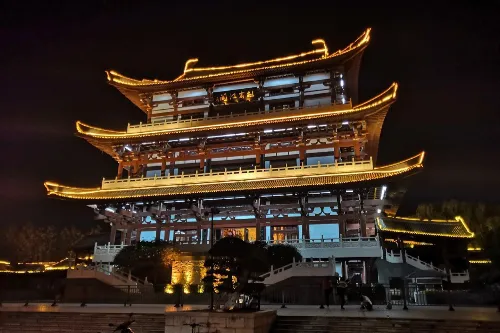
2nd Floor of Du Fu Pavilion
A statue of Du Fu stands in the center of the hall. The front of the hall features a large wooden bas-relief titled "Du Fu's Travels in Xiaoxiang", depicting his itinerary during his stay in Hunan. On both sides of the hall are Du Fu's poems and poetic paintings created by renowned artists such as Zhang Daqian and Lin Sanzhi, along with couplets, poetry-painted vases, antique redwood screens, flower stands, tables, and rare potted flowers and bonsai, filling the space with a strong cultural atmosphere.
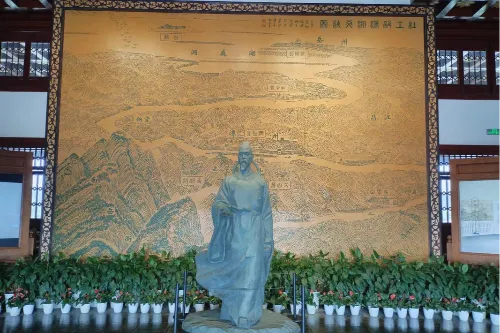
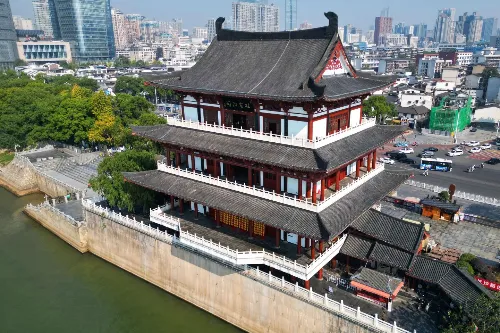
3rd Floor of Du Fu Pavilion
Focusing on showcasing Du Fu's poems written during his three-year stay in Hunan through poetry and paintings, the exhibition is divided into six sections: Family Background, Travels, Aspirations, Poetic History, Hunan Spirit, and Legacy. It displays more than 100 items, including pictures, poetry and painting works, versions of Du Fu's poems, and cultural relics. The exhibition walls adopt a lattice door and window design, echoing the architectural style of the pavilion.
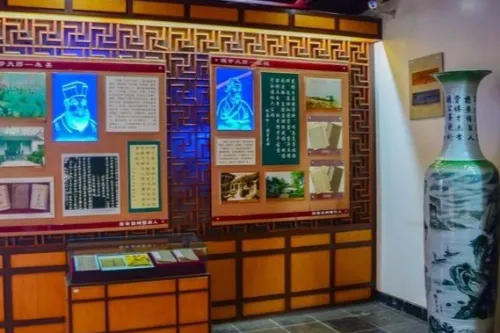
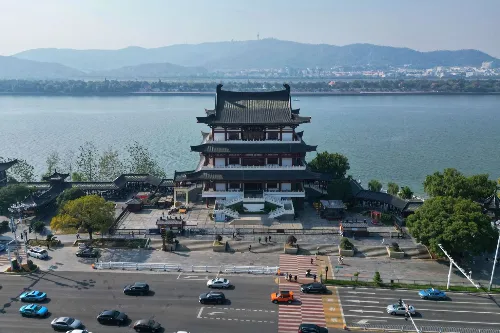
4th Floor of Du Fu Pavilion
It is divided into three small areas: Model Display, Literary Gathering, and Visitor Rest. A model of the river pavilion is placed in the center of the hall, with Qing Dynasty redwood furniture, four treasures of the study (writing brush, ink stick, paper, ink slab), antique calligraphy and paintings, Hunan embroidery, and rare stone specimens arranged on both sides. The four walls feature a series of paintings depicting famous cultural figures in Changsha's history, telling the stories of Qu Yuan, Jia Yi, and other historical and cultural celebrities.
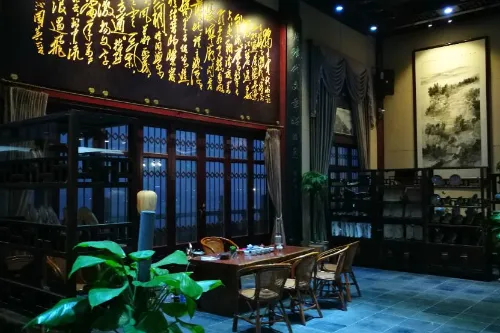
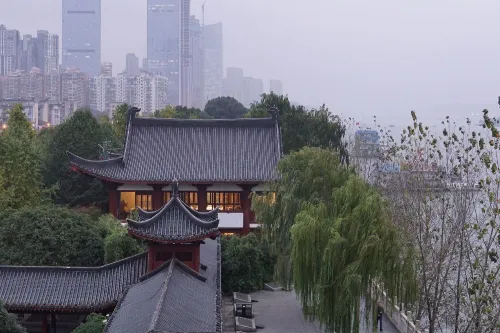
Poetry Stele Corridor
Located in the north-south connecting corridors of the river pavilion, stone steles inscribed with Du Fu's poems stand on both sides of the columns. The corridor includes fan-shaped and curved sections, with stone steles dotted throughout.
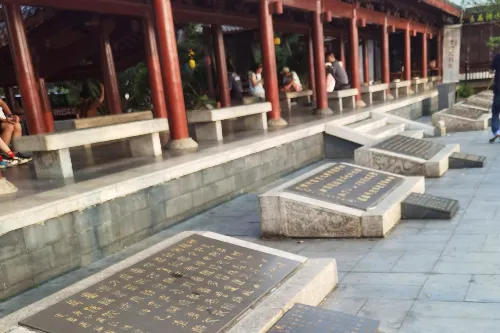
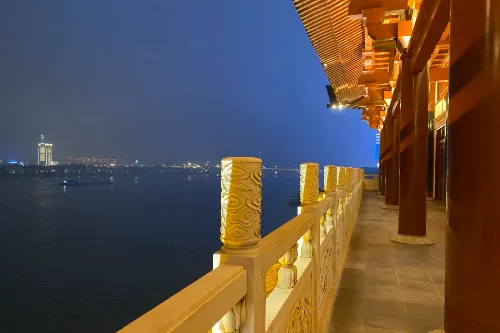
Hexagonal Stele Pavilion
Located to the north of Du Fu Pavilion, it has a double-eave roof. A stele stands in the center of the pavilion, recording the origin and construction process of Du Fu Pavilion by the Changsha Municipal Government.
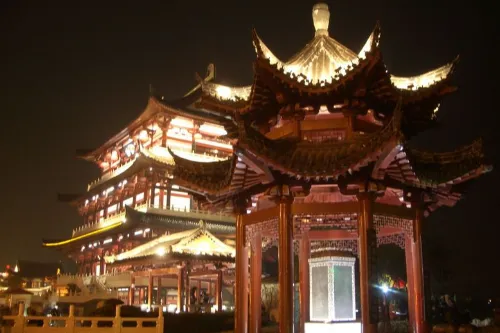

Tour Route
You can start your visit from the 2nd floor to explore the Du Fu Memorial Hall, then go to the 3rd floor to learn about Du Fu's life, and proceed to the 4th floor to appreciate the exquisite exhibits and the series of paintings on cultural figures. Afterwards, stroll along the Poetry Stele Corridor to admire the stone steles inscribed with Du Fu's poems. Finally, climb to the observation deck to overlook the beautiful scenery of the Xiangjiang River, Orange Island, and Yuelu Mountain. Alternatively, you can visit the floors and attractions that interest you first according to your personal preferences, then gradually explore other areas. If time permits, you can climb the pavilion in the evening to enjoy the beautiful scenery of the illuminated pavilion and the night view of the Xiangjiang River.
Travel Tips
- It is recommended to visit in the evening or at night to enjoy both the illuminated night view of the pavilion and the romantic atmosphere of the Xiangjiang River.
- Participate in the scenic spot's special activities, such as the "Happy Encounter" Tang-style interactive night tour, to experience Tang Dynasty culture immersively.
- You can bring your own notebook to collect 8 free themed stamps in the Tang-style space on the 1st floor.
- If you are interested in Du Fu's culture, you can learn about his experiences and poems in Changsha in advance to better enjoy the visit.
Notes
- Abide by the scenic spot's opening hours and enter and exit on time.
- Please do not speak loudly during the visit and keep quiet to avoid disturbing other visitors.
- Protect the scenic environment, do not litter, and do not touch the exhibits and cultural relics.
- Pay attention to safety when visiting high places such as the observation deck and do not lean on the railings.
- During holidays or peak tourist seasons, there may be a large number of visitors in the scenic spot. Please take good care of your personal belongings.
Transportation
- Metro: Take Line 1 to Nanmenkou Station, exit from Exit 1, and walk along Xiangjiang Middle Road for 10 minutes.
- Bus: Take Bus No. 1, 123, or 406 and get off at Du Fu Pavilion Station.
- Taxi/Self-driving: Navigate to "Du Fu Pavilion". There are paid parking lots nearby with a charging standard of 10 - 15 yuan per hour. Parking spaces are in short supply during peak seasons.
Opening Hours
The scenic spot is open from 9:00 to 22:00, and ticket sales and admission stop at 21:30. The "Happy Encounter" Tang-style themed space on the 1st floor of the pavilion is open from 10:30 to 21:30. The lighting time in summer is from 19:30 to 22:30.
Ticket Information
Ticket price: 18 yuan per person.
You can search for the official WeChat public account "杜甫江阁 城发文旅" to get the latest updates or purchase tickets online.
Online Booking
Click here to jump to the Trip.com ticketing platform for ticket purchase.


